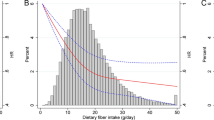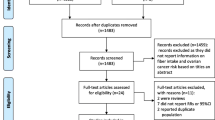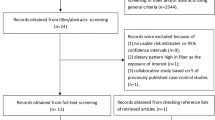Abstract
Purpose
Epidemiological studies have suggested a protective effect of dietary fiber intake on breast cancer risk while the results have been inconsistent. Our study aimed to investigate the association between dietary fiber intake and breast cancer risk and to explore whether this association is modified by reproductive factors and hormone receptor status of the tumor.
Methods
A total of 44,444 women aged 45 to 74 years from the Japan Public Health Center-based Prospective Study were included in analyses. Dietary intake assessment was performed using a validated 138-item food frequency questionnaire (FFQ). Hazard ratios (HRs) and 95% confidence intervals (CIs) for breast cancer incidence were calculated by multivariate Cox proportional hazards regression models.
Results
During 624,423 person-years of follow-up period, 681 breast cancer cases were identified. After adjusting for major confounders for breast cancer risk, inverse trends were observed but statistically non-significant. Extremely high intake of fiber was associated with decreased risk of breast cancer but this should be interpreted with caution due to limited statistical power. In stratified analyses by menopausal and hormone receptor status, null associations were observed except for ER-PR- status.
Conclusions
Our findings suggest that extreme high fiber intake may be associated with decreased risk of breast cancer but the level of dietary fiber intake among Japanese population might not be sufficient to examine the association between dietary fiber intake and breast cancer risk.

Similar content being viewed by others
References
Ferlay J, Soerjomataram I, Dikshit R, Eser S, Mathers C, Rebelo M et al (2014) Cancer incidence and mortality worldwide: Sources, methods and major patterns in GLOBOCAN 2012. Int J Cancer 136(5):E359–E386. doi:10.1002/ijc.29210
National Cancer Center (2016) Cancer Registry and Statistics. http://ganjoho.jp/reg_stat/statistics/stat/summary.html.
Jemal A, Bray F, Center MM, Ferlay J, Ward E, Forman D (2011) Global cancer statistics. CA Cancer J Clin 61(2):69–90. doi:10.3322/caac.20107
Althuis MD, Dozier JM, Anderson WF, Devesa SS, Brinton LA (2005) Global trends in breast cancer incidence and mortality 1973–1997. Int J Epidemiol 34(2):405–412. doi:10.1093/ije/dyh414
Ferlay J, Soerjomataram I, Ervik M, Dikshit R, Eser S, Mathers C et al (2013) Cancer incidence and mortality worldwide: IARC cancerbase no. 11. International Agency for Research on Cancer, Lyon
Ferlay J, Shin H-R, Bray F, Forman D, Mathers C, Parkin DM (2010) Estimates of worldwide burden of cancer in 2008: GLOBOCAN 2008. Int J Cancer 127(12):2893–2917. doi:10.1002/ijc.25516
Shimizu H, Ross RK, Bernstein L, Yatani R, Henderson BE, Mack TM (1991) Cancers of the prostate and breast among Japanese and white immigrants in Los Angeles County. Br J Cancer 63(6):963–966
Goldin BR, Adlercreutz H, Gorbach SL, Warram JH, Dwyer JT, Swenson L et al (1982) Estrogen excretion patterns and plasma levels in vegetarian and omnivorous women. N Engl J Med 307(25):1542–1547. doi:10.1056/NEJM198212163072502
Chandalia M, Garg A, Lutjohann D, von Bergmann K, Grundy SM, Brinkley LJ (2000) Beneficial effects of high dietary fiber intake in patients with Type 2 diabetes mellitus. N Engl J Med 342(19):1392–1398. doi:10.1056/NEJM200005113421903
Kaaks R, Berrino F, Key T, Rinaldi S, Dossus L, Biessy C et al (2005) Serum sex steroids in premenopausal women and breast cancer risk within the European prospective investigation into cancer and nutrition (EPIC). J Natl Cancer Inst 97(10):755–765. doi:10.1093/jnci/dji132
Aune D, Chan DS, Greenwood DC, Vieira AR, Rosenblatt DA, Vieira R et al (2012) Dietary fiber and breast cancer risk: a systematic review and meta-analysis of prospective studies. Ann Oncol 23(6):1394–1402. doi:10.1093/annonc/mdr589
Deschasaux M, Zelek L, Pouchieu C, His M, Hercberg S, Galan P et al (2013) Prospective association between dietary fiber intake and breast cancer risk. PLoS ONE 8(11):e79718. doi:10.1371/journal.pone.0079718
Ferrari P, Rinaldi S, Jenab M, Lukanova A, Olsen A, Tjonneland A et al (2013) Dietary fiber intake and risk of hormonal receptor-defined breast cancer in the European Prospective Investigation into Cancer and Nutrition study. Am J Clin Nutr 97(2):344–353. doi:10.3945/ajcn.112.034025
Yamamoto S, Sobue T, Kobayashi M, Sasaki S, Tsugane S, for the Japan Public Health Center-Based Prospective Study on Cancer Cardiovascular Diseases Group (2003) Soy, isoflavones, and breast cancer risk in Japan. J Natl Cancer Inst 95(12):906–913. doi:10.1093/jnci/95.12.906
Suzuki R, Iwasaki M, Hara A, Inoue M, Sasazuki S, Sawada N et al (2013) Fruit and vegetable intake and breast cancer risk defined by estrogen and progesterone receptor status: the Japan Public Health Center-based Prospective study. Cancer Causes Control 24(12):2117–2128. doi:10.1007/s10552-013-0289-7
Fukuda S, Saito H, Nakaji S, Yamada M, Ebine N, Tsushima E et al (2007) Pattern of dietary fiber intake among the Japanese general population. Eur J Clin Nutr 61(1):99–103
Tsugane S, Sawada N (2014) The JPHC study: design and some findings on the typical Japanese diet. Jpn J Clin Oncol 44(9):777–782. doi:10.1093/jjco/hyu096
Sasaki S, Kobayashi M, Ishihara J, Tsugane S, JHPC (2003) Self-administered food frequency questionnaire used in the 5-year follow-up survey of the JPHC Study: questionnaire structure, computation algorithms, and area-based mean intake. J Epidemiol 13:S13–S22
Tsugane S, Kobayashi M, Sasaki S (2003) Validity of the self-administered food frequency questionnaire used in the 5-year follow-up survey of the JPHC Study Cohort I: comparison with dietary records for main nutrients. J Epidemiol 13:S51–S56
The Council for Science and Technology, Ministry of Education, Culture, Sports, Science and Technology (2005) Standard tables of food composition in Japan. 5th revised and enlarged edn. National Printing Bureau, Tokyo
Willett W (1998) Nutritional epidemiology. 2nd edn. Oxford University Press, New York
Sasaki S, Matsumura Y, Ishihara J, Tsugane S (2003) Validity of a self-administered food frequency questionnaire used in the 5-year follow-up survey of the JPHC study Cohort I to assess dietary fiber intake: comparison with dietary records. J Epidemiol 13 (1 Sup):S106–S114. doi:10.2188/jea.13.1sup_106
Sawada N, Iwasaki M, Yamaji T, Shimazu T, Sasazuki S, Inoue M et al (2015) Fiber intake and risk of subsequent prostate cancer in Japanese men. Am J Clin Nutr 101(1):118–125. doi:10.3945/ajcn.114.089581
Kokubo Y, Iso H, Saito I, Yamagishi K, Ishihara J, Inoue M et al (2011) Dietary fiber intake and risk of cardiovascular disease in the Japanese population: the Japan Public Health Center-based study cohort. Eur J Clin Nutr 65(11):1233–1241. doi:10.1038/ejcn.2011.100
Ministry of Education, Culture, Sports, Science and Technology (2000) International classification of diseases for oncology. 3rd edn. WHO, Geneva
Holmes MD, Liu S, Hankison SE, Colditz GA, Hunter DJ, Willett WC (2004) Dietary carbohydrates, fiber, and breast cancer risk. Am J Epidemiol 159(8):732–739. doi:10.1093/aje/kwh112
Liu Y, Colditz GA, Cotterchio M, Boucher BA, Kreiger N (2014) Adolescent dietary fiber, vegetable fat, vegetable protein, and nut intakes and breast cancer risk. Breast Cancer Res Treat 145(2):461–470. doi:10.1007/s10549-014-2953-3
Gunter MJ, Xie X, Xue X, Kabat GC, Rohan TE, Wassertheil-Smoller S et al (2015) Breast cancer risk in metabolically healthy but overweight postmenopausal women. Cancer Res 75(2):270–274. doi:10.1158/0008-5472.can-14-2317
Suzuki R, Rylander-Rudqvist T, Ye W, Saji S, Adlercreutz H, Wolk A (2008) Dietary fiber intake and risk of postmenopausal breast cancer defined by estrogen and progesterone receptor status–a prospective cohort study among Swedish women. Int J Cancer 122(2):403–412. doi:10.1002/ijc.23060
Park Y, Brinton LA, Subar AF, Hollenbeck A, Schatzkin A (2009) Dietary fiber intake and risk of breast cancer in postmenopausal women: the National Institutes of Health-AARP Diet and Health Study. Am J Clin Nutr 90:664–671. doi:10.3945/ajcn.2009.27758
World Health Organization (2014) Systematic review on diet, nutrition, physical activity and survival and second cancers in breast cancer survivors. Imperial College London, London
World Cancer Research Fund International Continuous Update Project Report (2010) Breast cancer 2010 report: Food, nutrition, physical activity, and the prevention of breast cancer. Imperial College London, London
Dahm CC, Keogh RH, Spencer EA, Greenwood DC, Key TJ, Fentiman IS et al (2010) Dietary fiber and colorectal cancer risk: a nested case-control study using food diaries. J Natl Cancer Inst 102(9):614–626. doi:10.1093/jnci/djq092
World Cancer Research Fund/American Institute for Cancer Research (2014) Guideline for breast cancer screening based on effectiveness evaluation 2013. National Cancer Center, Tokyo
Iwasaki M, Inoue M, Sasazuki S, Sawada N, Yamaji T, Shimazu T et al (2010) Green tea drinking and subsequent risk of breast cancer in a population-based cohort of Japanese women. Breast Cancer Res 12(5):R88. doi:10.1186/bcr2756
National Cancer Center (2012) Cancer fact sheets: breast cancer. https://gco.iarc.fr/today/fact-sheets-cancers?cancer=15&type=0&sex=2
International Agency for Research on Cancer (2015) Cancer incidence 3 prefectures (1985–2010). http://ganjoho.jp/reg_stat/statistics/dl/index.html
Acknowledgments
We would like to thank the Iwate, Ibaraki, Niigata, Kochi, Nagasaki, and Okinawa Cancer Registries for providing their incidence data.
Funding
This work was funded by the National Cancer Center Research and Development Fund [23-A-31(toku), 26-A-2] and Kiban A: Burden of Disease Fund [25253051].
Author information
Authors and Affiliations
Consortia
Corresponding authors
Ethics declarations
Conflict of interest
M. Inoue is the beneficiary of a financial contribution from the AXA Research Fund as a chair holder of the AXA Department of Health and Human Security, Graduate School of Medicine, The University of Tokyo. The AXA Research Fund had no role in the design, data collection, analysis, interpretation or manuscript drafting, or in the decision to submit the manuscript for publication. All authors declare that they have no conflict of interest.
Additional information
JPHC Study Group members are listed at the following site: http://epi.ncc.go.jp/en/jphc/781/3838.html.
Rights and permissions
About this article
Cite this article
Narita, S., Inoue, M., Saito, E. et al. Dietary fiber intake and risk of breast cancer defined by estrogen and progesterone receptor status: the Japan Public Health Center-based Prospective Study. Cancer Causes Control 28, 569–578 (2017). https://doi.org/10.1007/s10552-017-0881-3
Received:
Accepted:
Published:
Issue Date:
DOI: https://doi.org/10.1007/s10552-017-0881-3




